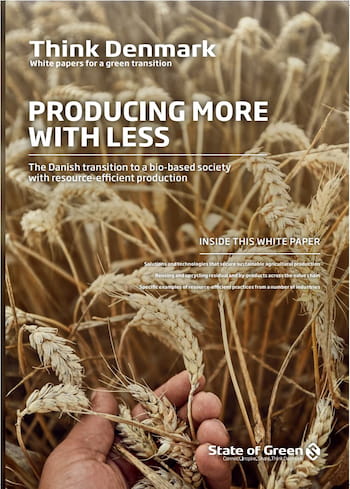Download our publication from producing more with less
This article is part of our publication ‘Producing More with Less’
Download nowPerspective
Bioenergy


The demand for agricultural output is increasing rapidly. The UN projects that in the next 40 years farmers will need to produce more food than they have in the past 10,000 years combined. Via the use of bio-based solutions, Novozymes is reducing greenhouse gas (GHG) emissions while generating additional feed and bioenergy from the same agricultural land base.
Take one acre of farmland planted with corn/maize, and see how much you can increase productivity. A new report from Novozymes estimates the additional value that can be generated using bio solutions in the agricultural value chain (crop production, livestock production and bioenergy). Using a life cycle analysis, the study begins by looking at an average one-acre U.S. cornfield, which, when using conventional farming methods, produces 153 bushels of corn used to feed 900 chickens.
Today, one acre of US cropland can provide feed for the production of approximately 900 chickens. The present study indicates that by adding biology to the value chain (enzymes and microbes), continued production of 900 chickens would result and, at the same time, provide 13 US gallons of biodiesel, 3 US gallons of starch-based ethanol, 32 pounds of protein-rich animal feed, 100 US gallons of cellulosic ethanol and 230 kWh of electricity. This extra production was possible with 12 pounds less pure phosphorus in the chicken feed. In addition, the resource savings and the bioenergy production (among other things) leads to a total reduction in greenhouse gas (GHG) emissions of 1.1 metric ton CO2 equivalents (CO2e) per acre.

This article is part of our publication ‘Producing More with Less’
Download nowThese results, for just one acre, become substantial when extrapolated to the U.S. national level. If these same bio solutions were applied to all US corn fields and in all of the US’s chicken production, it could result in 130 million extra US gallons of biodiesel, more than 10 billion extra US gallons of bioethanol (primarily cellulosic), 2.3 billion extra pounds of protein-rich animal feed, 21 TWh of bioelectricity, 120 million pounds of pure phosphorus saved and total GHG saving of almost 90 million metric tons (equivalent to taking 18 million US passenger cars off the road). This is while maintaining current chicken production on the existing agricultural land base.
Novozymes advances the sustainable use of resources in agricultural production as part of our actions in accelerating progress towards achieving the UN Sustainable Development Goals. Implementing biotech solutions across the agricultural value chain can contribute to climate action (SDG 13), renewable energy (SDG 7), no hunger (SDG 2), no poverty (SDG 1) and good jobs and economic growth (SDG 8).
publications
Resource efficient production
+15